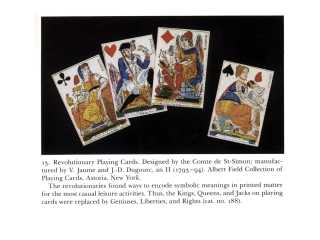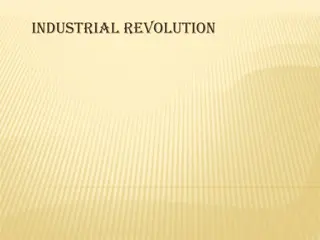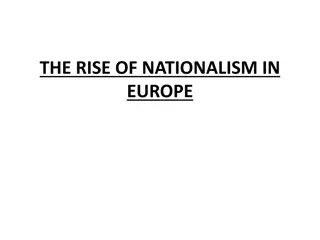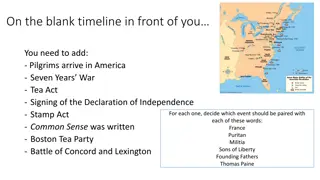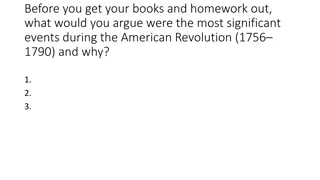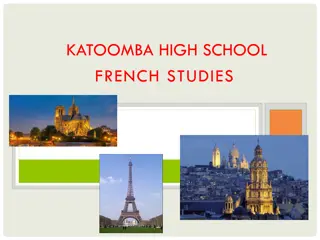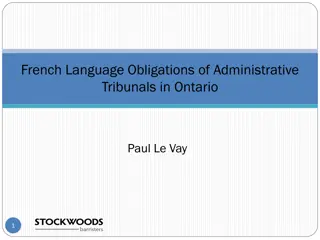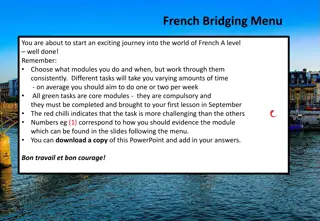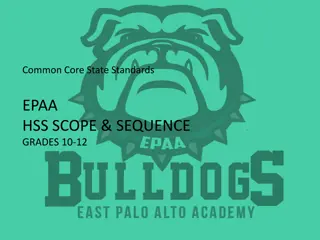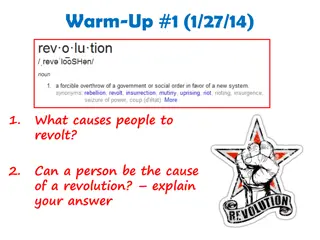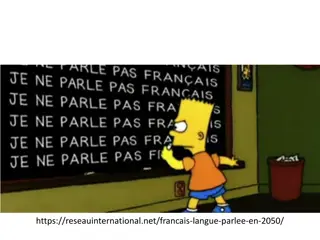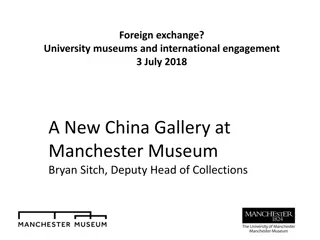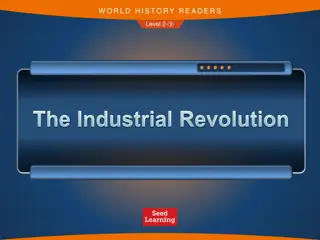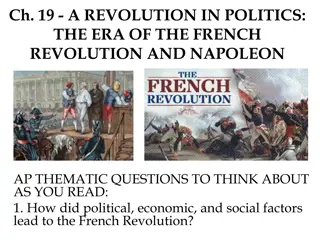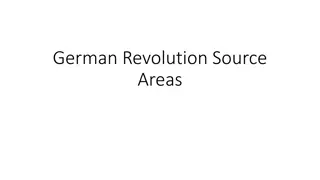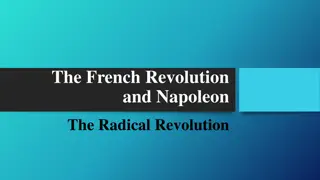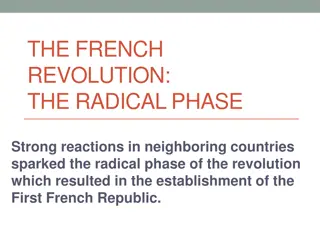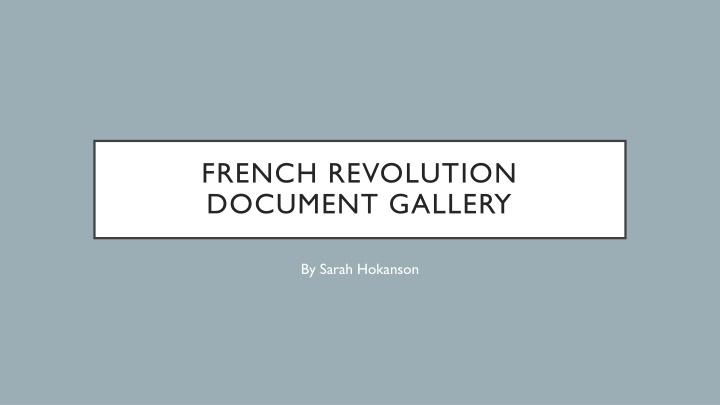
French Revolution Document Analysis Gallery
Explore a gallery of images and detailed descriptions shedding light on the causes of the French Revolution, from the reign of King Louis XIV to economic hardships and social inequalities. Discover key events and ideas that fueled this transformative period in history.
Download Presentation

Please find below an Image/Link to download the presentation.
The content on the website is provided AS IS for your information and personal use only. It may not be sold, licensed, or shared on other websites without obtaining consent from the author. If you encounter any issues during the download, it is possible that the publisher has removed the file from their server.
You are allowed to download the files provided on this website for personal or commercial use, subject to the condition that they are used lawfully. All files are the property of their respective owners.
The content on the website is provided AS IS for your information and personal use only. It may not be sold, licensed, or shared on other websites without obtaining consent from the author.
E N D
Presentation Transcript
FRENCH REVOLUTION DOCUMENT GALLERY By Sarah Hokanson
CAUSE ABSOLUTE GOVERNMENT King Louis XIV of France, known as the Sun King, became an absolute monarch in 1661 when he decided to rule France directly, instead of through a prime minister. He was 23 years old at the time and 18 years into his reign, having succeeded to the throne of France at the age of four.
CAUSE INEFFICIENT GOVERNMENT Although 14 July 1790 was a high point in the aspiration for unity, the preparation for the Estates General set the stage for later problems. In this image, representatives of each of the three orders depart together in a cart for the 1789 meeting of the Estates General at Versailles, where they will advise the King on behalf of the nation. The social differences depicted here and shown in the cahiers would not long remain under control.
CAUSE ECONOMIC PROBLEMS This image of peasants repairing a cart demonstrates both the hard work done by cultivators and their fragile economic situation, which could easily be imperiled by a broken cart. Under such circumstances, poor people constantly repaired durable and personal goods, such as carts or clothing, because they could not afford to replace them with new ones.
CAUSE THREE ESTATES This image shows "the people" as a chained and blindfolded man being crushed under the weight of the rich, including both clergy and nobility. Such a perspective on the period before 1789 purposely exaggerates social divisions and would have found few proponents before the Revolution, but the image does reveal the social clash felt so intensely by the revolutionaries.
CAUSE ENLIGHTENMENT PHILOSOPHERS This image demonstrates the necessity of nationalizing church property. It shows a peasant cutting the fingers off a priest s hands; a nobleman cannot bear to watch, but has no qualms about putting on the gloves the clergyman will no longer need. Although the focus is on the clergy, the noble s greed is clearly in evidence.
CAUSES AMERICAN REVOLUTION Thomas Paine (1737 1809) played a vital role in mobilizing American support for their own independence, and he leapt to support the French revolutionaries when Edmund Burke attacked. Elected deputy to the French National Convention in 1793, Paine nearly lost his head as an associate of the Girondins during the Terror. In his reply to Burke, Paine defended the idea of reform based on reason.They used this document and contributed it into there rights of man.
COMPONENTS NATIONAL ASSEMBLY AND TENNIS COURT OATH This amazingly rich sketch by Jacques Louis David is one of the most famous works from the French revolutionary era. The thrust of the bodies together and toward the center stand for unity. The spectators, including children at the top right, all join the spectators. Even the clergy, so villified later, join in the scene. Only one person, possibly Marat, in the upper left hand corner, turns his back on the celebration. And, in fact, David is commemorating a great moment of the Revolution on 20 June 1789, in which the deputies, mainly those of the Third Estate, now proclaiming that they represent the nation, stand together against a threatened dispersal.
COMPONENTS FALL OF THE BASTILLE This hand colored engraving equates the taking of the Bastille with the rise of the Third Estate against the clergy and nobility. A commoner in a black hat sporting a tricolor cockade plays the bagpipe triumphantly over the fallen lion of the absolutist monarchy. To the side, a revolutionary soldier raises his sword to menace a priest.
COMPONENTS DECLARATION OF THE RIGHTS OF MAN AND THE CITIZEN This image of the Declaration of Rights of Man and Citizen includes a fascinating mix of symbols. By arranging the articles on tablets, the artist clearly meant to associate this document with Moses Ten Commandments. Such a link could establish the revolutionaries handiwork as equivalent to that of God. Reinforcing this is the all seeing eye located at the top of the tableau. However, this is not the God of biblical revelation but of the Masonic order, which espoused a deistic vision of a benevolent creator and founder of general laws. This deity was not a worker of miracles. Thus the Declaration results from the actions of humankind, who enjoy the beneficence of the generous deity
COMPONENTS MARCH ON VERSAILLES This drawing shows a group of women presumably leading the procession to Versailles. Dressed as servants and shopkeepers, the women are depicted as a military unit led by one woman in the role of an officer on the horse and by a drummer, followed by the rest carrying the common weapons of pikes and pitchforks.
COMPONENTS NATIONAL ASSEMBLY REFORMS 1789-1791 The deputies of the Commons finally declared they were prepared to proceed alone, and, on June 17, 1789, formed a National Assembly In the center standing on a table is the astronomer Jean-Sylvain Bailly, who was appointed president of the Third Estate on May 5, 1789. He reads the text of the oath.
COMPONENTS LOUIS AND FAMILY ATTEMPT TO ESCAPE This engraving depicts the King, his wife, and his children meeting at half past midnight on 21 June 1791, about to board a carriage in which they will flee secretly from Paris toward the border. The King and Queen were poorly disguised as servants to a German noblewoman. Since most French people outside of Paris had never seen the King or Queen in person, they expected to avoid recognition if only they could get clear of the capital and the surrounding towns.
COMPONENTS FRANCE AT WAR WITH AUSTRIA AND OTHER EUROPEAN NATIONS This engraving uses classical figures to depict allegorically an alliance of Prussia, Britain, and Austria, represented as "Tyranny, Hypocrisy, and Pride," who seek to divide the map of France among themselves, while the French Nation prepares to resist so as to bring peace and tranquility to all of Europe.
COMPONENTS EXECUTION OF LOUIS XVI This image shows much the same scene on the platform as the preceding one, but the surroundings are much more in evidence. Visible here are the troops. Eight to nine thousand were mobilized to avoid any efforts at rescue. This is clearly the last moment as Louis XVI has his coat off and his hands secured behind his back. The confessor steadies the King.
COMPONENTS ASSASSINATION OF MARAT This engraving, like the preceeding image, portrays Marat s assassination at the hands of Corday. In both images, Marat appears serene, a reminder that Marat s supporters saw him as a Christ incarnated on behalf of the Revolution.
COMPONENT REIGN OF TERROR The extremely respectful view of sans culotte militancy is evident in this image, engraved by the revolutionary sculptor Berthault and based on a painting by Fragonard, the son of the famous old regime painter. Imitating an old master s interior scene, it shows a committee somberly meting out revolutionary justice.
COMPONENT EXECUTION OF ROBESPIERRE This painting from 1877 shows in romantic style Robespierre dying in a large room, surrounded by soldiers and others. His shirt is bloodied and his left hand is on his chest; visible in the background is a tablet of the Declaration of Rights of Man and Citizen, suggesting that it was the cause for which Robespierre died. The image might be seen as a moment of secular apotheosis.
COMPONENT DIRECTORY After Jacobin control faded, with its repression of exuberant social life as well as political diversity, the following years saw a rebirth of open pleasures. This image focuses on fashionable men and women enjoying the good life. Some contemporaries would see this as excessive and self indulgent, and far bolder displays of sexuality and materialism. Indeed, what one sees here was at least surprising since only the nobility and the very rich had before 1789 experienced much in the radiant way evident in this image.
CONSEQUENCE REPUBLIC ESTABLISHED This poster includes the Republic s new calendar under an image of Marianne, another symbol of the Republic as well as the ultimate expression of revolutionary liberation from the past. Yet without her pike, calmly reading a book with a cupid around, she is more the mother of this new system than a warrior for liberty, as in other prints.
CONSEQUENCE NEW INSTITUTIONS The Estates General, reborn as the National Assembly, finished its work by completing a new constitution. This document provided for an executive the King as well as a legislative body. Suffrage was male and restricted to certain economic levels. Overall, it was a moderate document that created a constitutional monarch and privileged the wealthy to a considerable degree at a time when the monarchy had discredited itself and popular classes wanted more. In retrospect, one could wonder how contemporaries believed this constitution would survive.
CONSEQUENCE CONCEPT OF WAR The revolutionary wars, which would continue in one form or another until Napoleon s defeat in 1815, were different from other conflicts in early modern Europe. In this struggle that emerged in 1792, both sides thought they were fighting for different ideas of governance and society: political democracy versus traditional hierarchy. When England and France had fought before 1789, they might have also clashed over political ideas, but it was clearly a war between dynasties over economics and geographical assets. The one other struggle that could have such varying ideals concerned religion. This image promoted the French as republicans, fighting for a constitution. Note that the constitution is presented as two tablets, as in many renditions of the Ten Commandments. The opponents are described as slaves.
CONSEQUENCE CONDITIONS OF THE PEASANTS This is a painting is of peasants working in farm following the French revolution.
CONSEQUENCE CHURCH This is painting of monks and nuns enjoying there freedom following the French revolution.
CONSEQUENCE BOURGEOISIE/MIDDLE CLASS This piece of crockery further demonstrates the sentiments of social unity so prevalent at the Festival of Federation. The crossed sword, pike, clerical staff, and bonnet symbolize the union of the nobility, peasants, clergy, and workers, respectively.
CONSEQUENCE INFLUENCE ON OTHER COUNTRIES Toned down and transformed from her revolutionary past, the Statue stands for liberty, even without a pike and a Phrygian cap. Furthermore, the Statue, a gift from France and a marvel of engineering, still connotes revolution because of the identification between France and revolutionary notions.

